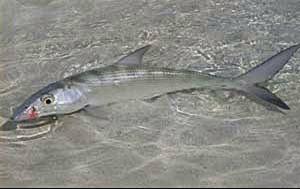
|
Getting to Know Bonefish
 This may come as a surprise, but
becoming familiar with this popular
fly fishing species is more challenging
than one might expect. Researchers
and flat anglers alike have wondered
for years about bonefish behavior.
Finally, after all this time there
are some answers.
This may come as a surprise, but
becoming familiar with this popular
fly fishing species is more challenging
than one might expect. Researchers
and flat anglers alike have wondered
for years about bonefish behavior.
Finally, after all this time there
are some answers.
There are three species of bonefish
Albula vulpes, A. nemoptera, and
Pterothrissus belloci, all of which belong
to the very large “bony” fish
class called Osteichthyes. The species
fly anglers pursue, Albula vulpes inhabits
warm, shallow, coastal waters
worldwide. A. nemoptera, commonly
known as the longfin bonefish, resides
in thin water near outlets around high
islands in the western Atlantic and
eastern Pacific. Pterothrissus belloci
lives in only deep water and humans
rarely ever encounter it.

Though it is not a highly esteemed food species, the Bonefish, Albula vulpes, is
one of the most important game fishes in the world, and it is also occasionally
used for bait. Its weight and length may reach 10 kg and 104 cm respectively,
though a more representative size would be about a third of that. Bonefish appear
blue-greenish above, with bright silver scales on the sides and below. Dark
streaks run in between the rows of scales, predominantly on the dorsal side. The
body is long, thin, and cigar shaped, with a bluntly cone-like snout. The bonefish
has a unique adaptation for tolerating oxygen-poor water; it inhales air into a
lung-like airbladder to supplement oxygen from the water. It is sometimes mistaken
for the ladyfish, a similar species. Linnaeus first described the bonefish in
1758. Its scientific name can be translated as “white fox.”
|
These animals are well-disguised
predators. They ride rising tides to
wander warm, inshore saltwater flats
in search of bottom-dwelling prey.
They feed on these tides at all hours,
filling their oversized stomachs. Insatiable
grazing machines, they are
uniquely equipped to harvest their
meals. Bonefish mouths operate with
shell-shattering jaws, a tongue as hard
as ceramic and powerful grinding
plates. Acute color vision, sharp hearing,
mirrored camouflage, and lightning
speed protect them from capture
by enemies. Certainly, they are the
best inshore flats hunter.

The Bonefish prefers reefs, shallows, estuaries, bays, grass flats, and other brackish
areas at a depth from 0 to 84 meters. It is found worldwide in subtropical warm
seas. In the Eastern Pacific, its range includes waters off California to Peru; the
Western Atlantic range stretches from North Carolina to Florida, the Bahamas,
the Gulf of Mexico, the Antilles and the rest of the Caribbean to Brazil. |
Ask an angler, he or she will probably
tell you they find no other game
fish more challenging to stalk, hook,
play, and release than Albula vulpes.
The species has an interesting mixture
of traits that have escaped 125 million
years of predation, making it the all
time ultimate survivor and most sought
after fly-fishing game fish around today.
For more information on Green Reef please contact us at (email: [email protected] or telephone us at 226-2833.
Back to Reef Briefs Main page
|

 This may come as a surprise, but
becoming familiar with this popular
fly fishing species is more challenging
than one might expect. Researchers
and flat anglers alike have wondered
for years about bonefish behavior.
Finally, after all this time there
are some answers.
This may come as a surprise, but
becoming familiar with this popular
fly fishing species is more challenging
than one might expect. Researchers
and flat anglers alike have wondered
for years about bonefish behavior.
Finally, after all this time there
are some answers.

